The Last Spell is a game that has 20 weapons and their efficient usage can be stressful to new players, especially when a dead guy is trying to eat you. This guide is meant to alleviate the pressure you feel by providing you with resources to select the best weapons for the right heroes under most situations and use them effectively. My aim is to cover weapon choices, perk trees, leveling order, and the pros, cons and play-style of each type. This guide will give you builds that will reliably win you games, and not waste your time.
Introduction
There are many ways to play The Last Spell, and an exponential amount of weapon combinations. This guide gives you 20 solid Specialist choices that will let you know exactly what each weapon can and can’t do, and is designed for intermediate players who want to beat the game on the highest difficulties. I want to stress at the outset that this is not my “personal” tier list and opinions; I’m trying to give people the data on specialized weapon builds so they can make the right decisions. Everyone has their favorite weapon, but I’ve kept my personal biases out of this guide. If this was a biased guide I would have a four part section on Pistols. Then I start blastin.
Please read the following Important Notes section, then skip to whatever weapon you want to use or ended up with. If you have all day you can also read the entire thing!
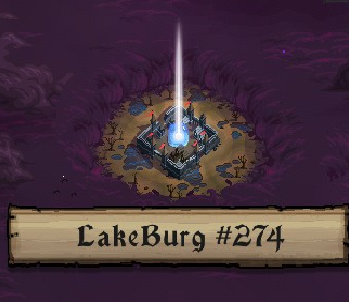
Important Notes
All weapons are not available when you first start the game. You need “Meta” progression (the side leveling system after you win nights that gives you different kinds of essence which you donate to various glowing voices in exchange for power) to unlock them all. As you unlock them, you can also unlock different “styles” of those weapons, such as a Silver Sword or an Adamantite Longbow. Keep in mind that the “styles” of weapons do not make them “better” per se, they just each have different “native” effects tied to them, and you may need different styles depending on what your hero lacks or wants to specialize in. For example, Silver Spears increase mana regen, always, compared to Steel ones, which do not, but instead increase Armour. However, the biggest factor on weapon damage and thus effectiveness is their *Tier*. The weapon Tier is denoted by a roman numeral on the image of the weapon — I, II, III, IV, and V. Level V weapons always do more damage than level IV ones. Although, if you factor in rarity or secondary stats, or personal needs for that specific hero there are sometimes reasons to use a lower Tier weapon over a higher Tier ones. Just keep an eye on it. As a general rule if you’re confused: higher level is better.
Meta Progression
A small number of these builds will under perform until you unlock important meta upgrades. Early meta heroes have 4 base AP, which means almost no weapon will feel good, ever. Starting AP is the most important for everyone, under every circumstance, followed by archetype (melee, ranged, mage) specific bonuses to heroes. You can’t do much with the starting AP you get when you first play the game and this is by design to get you to play more, so focus on unlocking that first as it opens up a ton of build options. At full meta unlocks you can do anything and beat the game on high Apocalypse with (just about) anyone. At half meta unlocks, you can do almost everything. If you try a build in this guide and you get absolutely blown out, consider how much meta you have. When I wrote the majority of the builds in this guide, I had just over half, so what an average player would have after investing a few hours. Ultimately, no weapon will do anything if your circle is constantly dying because you don’t push back fog, or have a good economy strategy. Zero builds in this guide need full meta to operate. Zero builds in this guide need full meta to excel. But with more meta you get more options.
Perks In General
The majority of the perks in The Last Spell aren’t great. More than half. Most perks simply do nothing most of the time. The law of this guide is taking reliable perks that always have an impact on the game. We can quibble about edge case perks, but there are *clear* winners for what the best perks are, and when and why you take them. Most builds will have one or two perks that are flexible. But there are some perk choices that are absolutely not negotiable if you want your builds to reach peak statistical performance (like Thrifty and Avid Learner, which are taken on every hero no matter what). If you want to take Fatality, or Trapper, or Play Dead because it fits your playstyle or you think its cool, go ahead, but most of the time they do nothing. As a final word on perks, this is not a perk guide, it’s a weapon guide. It’s meant to show you how to get the absolute most of whatever weapons you end up with, or want to use. A full perk guide would be pointless because lots of perks are awful, some are amazing, and the rest are situational. I also imagine they will be more balanced in the future, and so I will write a full perk guide when they are.
Because most builds have a couple flex perks here and there, outside of obvious must haves, if you play the game a bit you’ll understand that you can’t follow this perk system every single game, just most games. Some games a hero will be starved for mana because the spawned with Insomniac. Then you’re gonna want to Mana Collector. Adapt.
Offhand Weapons
Offhands are extremely good, but extremely rare, so they don’t always feature in this guide. Usually you just get an old door that you fashion into a shield, and it’s whatever. But if you get one, consider using it instead of a shield, even if this guide has the character using a shield. If you take specialist and have an offhand weapon of the same type as your specialized weapon, you get the attack number boost on the offhand as well. For example, with an offhand and mainhand hammer, you get six uses of Stomp. Unfortunately this is often irrelevant because of AP limitations.This is not to mention the Teleportation Crystal, a very rare offhand that wins entire games for you. If you get one, you’ll want to skip right to the “Deathmage” section of this guide.
Weapon Specialization
Specialist is a perk taken on all the builds in this guide. This locks you into one weapon set. This is *usually* optimal, because compared to other perks, Specialist does a lot. It gives you 20% flat damage (before multipliers, making it even more when factored into archetype modifiers) and allows you one more use of every skill on that weapon. There are definitely a lot of cases where having a second set of weapons will be better. Until you are level 7, you want to always have a second set if you have other weapons kicking around you aren’t selling, or if you get an absolutely busted Epic rarity weapon but have no main user. Weapons in your offset still give you the stats even if they aren’t equipped. So considering using an offset until level 7, even just as stat sticks, then ditch it for the reliable 20% damage increase of Specialist. Are there cool builds that use a sword in the main, and then a pistol in the offset, and then a teleportation crystal instead of a shield? Probably. Is it sometimes better to not take specialist, but instead put another copy of the exact same weapon in your offset to double up on its very important native stats? Yes, usually. But most of the time you aren’t going to get that exact combination of items unless you force it, and once again this guide is about giving most players options for most games. At a later date, I will be incorporating some non-specialist builds into this guide once weapon balance evens out. Advanced players will be able to find non-specialist weapon combinations that work just as well, if not better than these builds. That requires some luck though, and this guide is about consistency.
Hero Classes
Yes, there are clear hierarchies between classes of heroes. Archer types being the best, then Mages, then Melee. If you want to play the most optimally on an unbalanced early access game, stop reading this guide and play 6 archers and dominate every game.
However, this likely will not always be the case, and that’s one of the reasons why this guide exists; to provide a groundwork for builds as they become more and more viable. Even according to how things stand now, there at least three, maybe four, melee weapons that I would use on Apocalypse 5. That’s not bad. Melee get a lot of hate, and a lot of it is deserved, but if you build them correctly they can do work. Not as much work as a Shortbow mind you, but work.
Weapon Tier Lists
This guide contains a tier rating for each weapon and a consolidated tier list at the end of the guide. For a lot of power players, this is all that matters. I myself am a player like this, but I like finding other options in these kinds of games. You can skip to the tier list if you want and be good right out of the gate. But haggling over which weapon belongs is which tier, outside of probably the top 5 and bottom 5, is pointless. The ten or 12 weapons in the middle all do something, and can be better than their tier in the hands of the right hero.
Melee Weapon Introduction
Melee are the only classes that consistently have to mitigate oncoming damage. You do this in two main ways: armour and dodge. Armour soaks hits and refills every turn, Dodge avoids everything entirely. Each melee build in this guide can be done with Armour OR Dodge, and should adjust two perks accordingly: Armour users take Berserk, Dodge users take Adrenaline Rush. Berserk does not trigger on Dodge, and Adrenaline Rush does not trigger on soaking a hit with your armour. Besides that, they aren’t much different. Secondary defensive stats are also weighed differently based on your mitigation source. Dodge doesn’t care about Resistance or Block as much and can build glass-cannon, although will still want a good chunk of health as its easier to get and comes on all kinds of speedy gear. Armour users, however, want Resistance and Block as well. It is fairly easy to reach high breakpoints of Dodge and become invincible. It is even easier to hit high breakpoints of Armour, Resistance and Block and become invincible. Mixing a bit of secondary mitigation stacks is good for both types, but don’t go overboard, because being invincible isn’t good. Not dying yourself doesn’t matter if your circle is getting attacked and you can’t kill anything. Ultimately this game is a DPS race. Unless you’re actively killing things each turn, or setting up big kills for later, the machine breaks down. Getting huge doesn’t make you hit harder, unless the devs add a perk like that. (Devs, please add a perk like that.)
In addition to this, most melee heroes will want heavy and regular investment into movement points. The cap is 12. You want to be there or close on most melee heroes eventually, because you aren’t hitting anything if you can’t get in range. On non-mobile melee weapons, you’ll sometimes want to both get into the pack and get out if your mitigation is not up to par to deal with being attacked a lot. This is why almost all melee builds want Swift as the Wind. A sub-optimal perk much of the time, but if you’re playing well and hitting a lot of targets, it can exponentially boost your damage, or save your life. Lack of mobility can be made up for with good range on skills. this is why weapon builds that force you into low mobility heroes can still excel if they have a secondary stat called Skill Range. Sledgehammers are a good example of this (and of course, all ranged weapons). This is why mobility and range feature in the same category for my rating system.
Anyway, let’s build that Blacksmith and start swinging.
Spear – The Sentinel
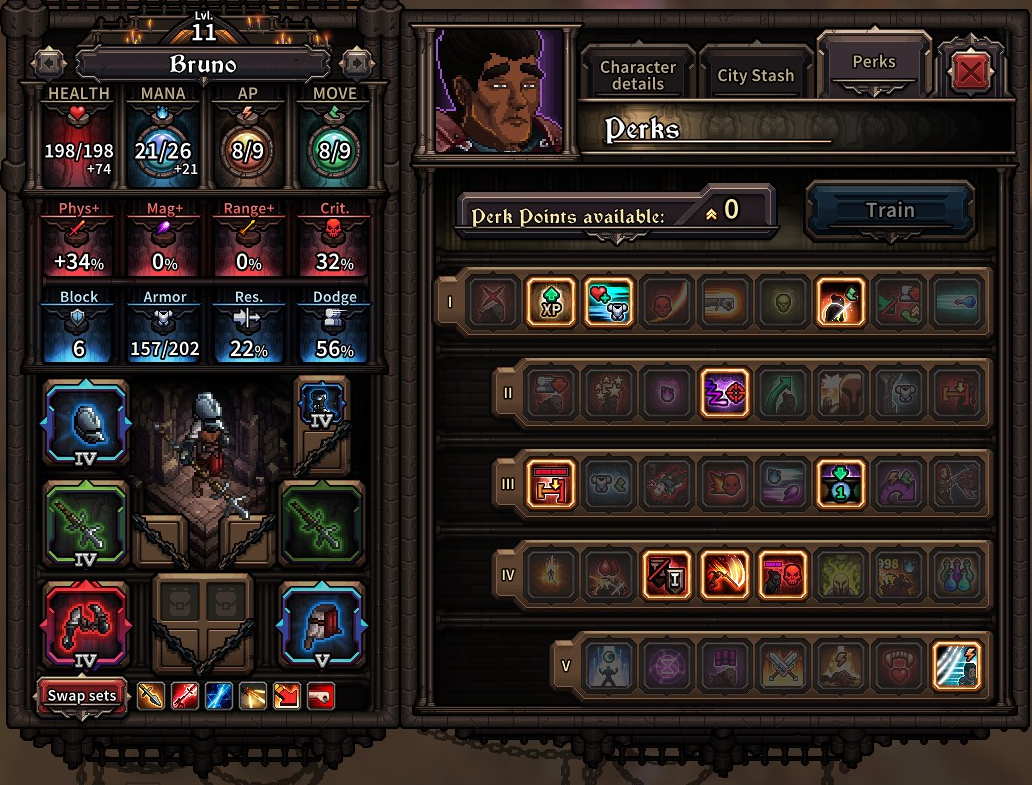
Pros: The Sentinel is a favourite of new players because Spears are one of the first weapons you can generate in the game that actually have pretty good frontal AOE. This is true. Triple Swipe is very good. Skewer, a Multi-Hit skill, also eliminates armoured monsters like Lancers pretty well, and if you invest in Multi-Hit you can LARP as an Assassin dagger user and kill multiple spread-out targets a turn. You also get big Momentum hits, but generally your other skills are better.
Cons: Spear accuracy, like One Handed Axes, sucks. Most spears have an accuracy malus, some don’t make up for it with anything useful. All spear skills cost 2 AP, even the basic Impale strike, meaning you will constantly find yourself out of things to do on lower meta and unless you position well. The Sentinel might not seem like a very positionally intensive hero, but he is; he can’t afford to waste AP on not taking the exact right fights. If you choose his targets correctly, he’ll put up a decent amount of numbers for a melee unit. But if you screw around and don’t plan your attack well, you’ll kill nothing and be out of AP. The Sentinel also needs a lot of mana, more than other melee classes, because Triple Swipe costs a lot and you want to use it every turn, multiple times once you get Specialist. Even with Thrifty, you’ll probably need a Mana Well in town. This is a lot of investment in a lot of things for a melee unit that also needs movement and defenses. You also can’t really afford to be crit-based because you need so many other stats, leaving you on tanking duty. Also personally for me, the animation on Skewer takes way too long and makes me sad IRL 🙂
Playstyle: Tank with AOE Damage
Stand in the pack, get a good cone with Triple Swipe, and swipe. If you get a bit of Skill Range and Multi-Hit, you can also pick off stragglers and armoured units with Skewer. Can be Armour or Dodge, Dodge preferably because you’re AP starved, so make sure you’re attacting monsters so you can get precious AP return once you can buy Adrenaline Rush.
Stat Priority: Movement Points, Multi-Hit, Physical Damage, Dodge, Mana, Crit if you can swing it.
Perk Order: Avid Learner, Initiator, Swift Like the Wind, Thrifty, Confident, Specialist, Relentless, Coagulation, First Blood, Energized.
Verdict:
Damage: B
Defense: B
Mobility: C
Rating: B-Tier
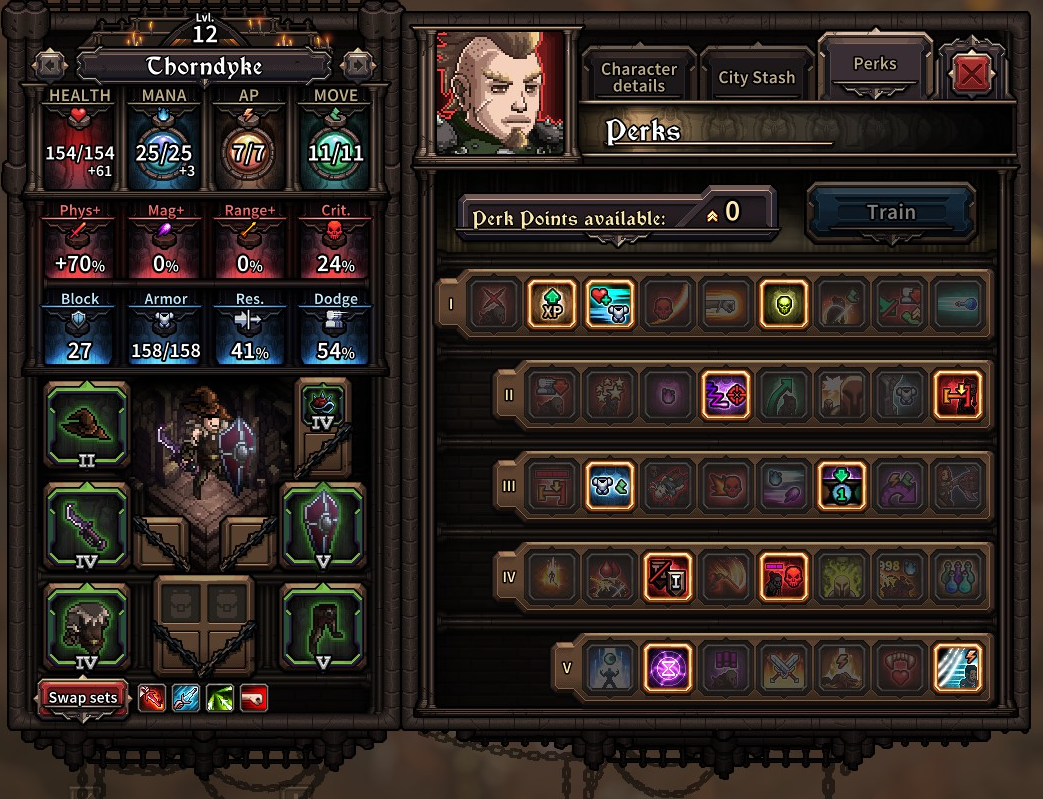
Pros: High single target damage, high Multi-Hit target damage, and the ability to execute armoured units. The Assassin, much like the Pistol-wielding Outlaw, is a class that operates differently than its weapons might lead you to believe. The Assassin is a ranged unit the same way the Outlaw is a melee unit. Your weapon might be melee, but you want to be at range. You aren’t so much as stabbing people as you are throwing dozens of poisoned knives in their face every turn. This means you have a lot more utility than a lot of other melee classes, with top tier damage. A run saver.
Cons: Without Multi-Hit investment, you aren’t doing much. Poisoned Daggers is the skill you want to use, and it’s close to the only skill you want to use. You will absolutely kill Isolated or armoured targets with your other two abilities, but that requires you to be next to something, and unless you’re necking someone on the way out of your dagger-throwing spree, it’s often better to just save one last dagger toss for them, too. This leads to a somewhat one-dimensional playstyle where you only ever use one ability. It’s a damn good ability though.
Playstyle: Carry / Single Target
An Assasssin can carry a wall with investment. Fairly low investment, too. With no Multi-Hit you are relegated to sadly stabbing stragglers, but with Multi-Hit you can kill upwards of 20 targets a turn, which puts you in carry status. Good dagger users are very good, bad dagger users are very bad. Just use this guide and build them correctly.
Stat Priority: Multi-Hit, Skill Range, Physical Damage, Crit, Poison Damage/Crit Damage
Perk Order: Avid Learner, Initiator, Poison Damage, Cherry Picking, Thrifty, Amour Master (if heavy armour) / Coagulate (if dodge), Specialist, First Blood, Adrenaline Rush, Hex.
Verdict:
Damage: A
Defence: B
Mobility/Range: A
Rating: A-Tier
One Handed Hammer – The Knight
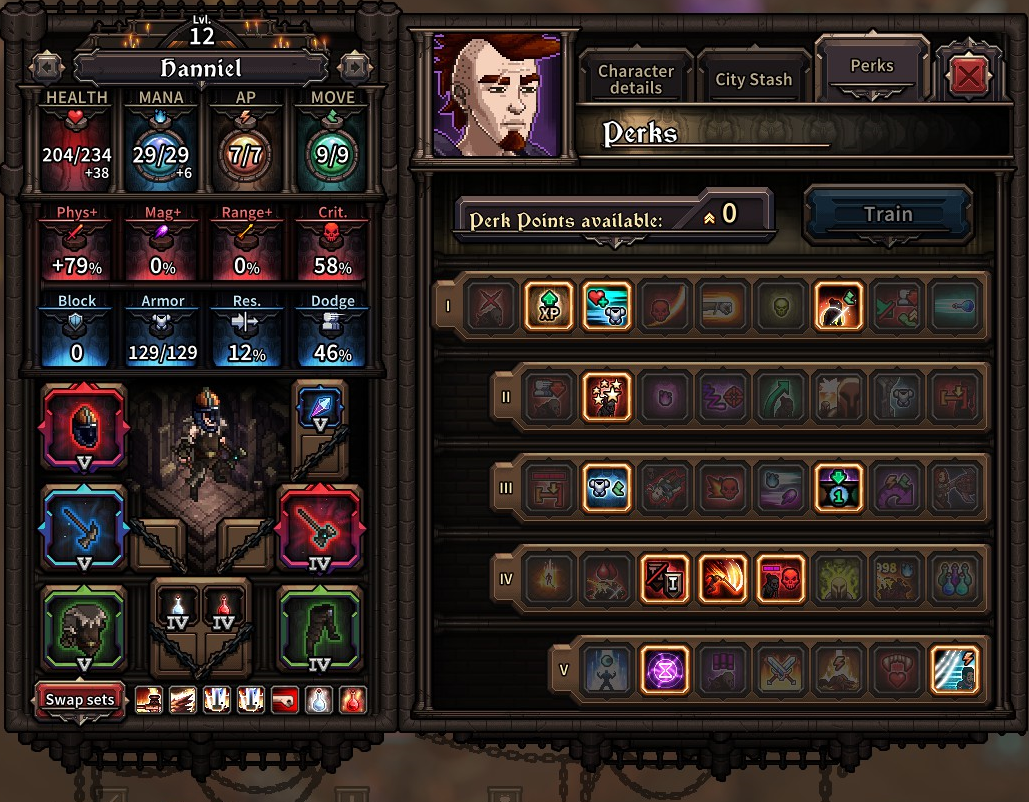
Pros: A tanky hero that can reliably stun waves once specialist is taken. Very good at executing debuffed enemies, as Crush has a double damage opportunistic modifier. Fairly AP light, once you get to above 6 AP a turn, you can dish it out. You aren’t unhappy to have this guy, he just takes a lot of work to get going and can sometimes let you down.
Cons: Extremely limited range. Low aoe damage. Has to be in the very thick of the pack in order to get the most value for stuns, making them more vulnerable than other melee options, which have access to movement skills and can affect the wave from afar. Must build crit to do any serious aoe damage.
Playstyle: Tank/Disruptor
Run at the crawlers and stomp your way through the pack until you’re surrounded, then Crush the ones hit by your debuffs or others.
Stat Priority: Move points, Crit, Physical damage, Armor or Dodge, Stun Chance, Crit Damage.
Perk Order: Avid Learner, Swift as the Wind, Stunning!, Thrifty, Coagulation, Specialist, Relentless, Hex, Adrenaline Rush (if dodge) / Berserk (if armor), First Blood, Patient
Best Friend: Anyone who can set up debuffs. a wand user can also be a good friend as your main attack is very ap light, and the transfer ability on wands can top you up on ap and give you much needed movement points
Verdict:
Damage: C
Defence: B
Mobility/Range: C
Rating: C-Tier
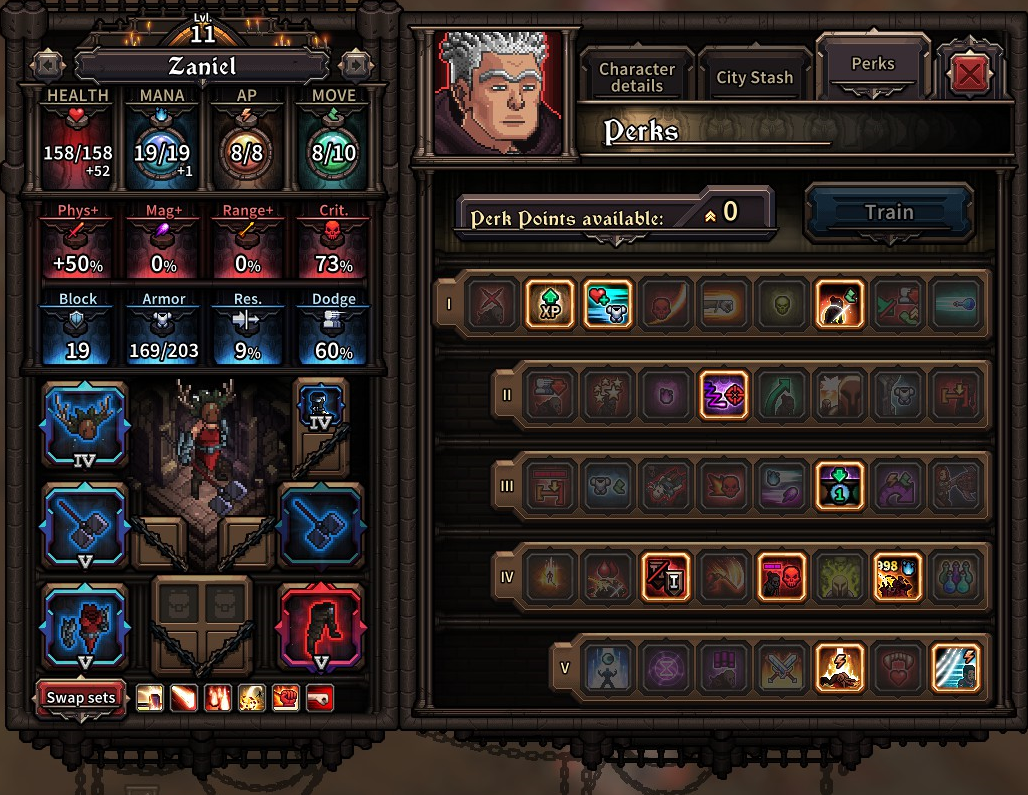
Pros: If the Battlemage (Scepters) is a mage pretending to be a melee class, the Paladin is a melee class pretending to be a mage. Her most effective skill, Mega Stomp, is a Propagation chain, meaning you want to invest in the Propagation Bounce stat. Her second skill, which is also quite good, is Ground Smash, which is virtually a carbon copy of the Fireball spell cast by the Tome of Secrets, except it cannot be evaded. So essentially, if you equip a Sledgehammer, you’re a more mobile, but slightly less damaging Archmage. You also have access to a teleport-style followup skill and a large AOE stun. You also don’t need as many movement points as other melee units, as your skills have great range on their own, and be be supplemented with more Skill Range, something other melee doesn’t get a lot of use from.
Cons: Skill range. Skill range. Skill range. You need it. You need it more than any other hero in the game. This stat is hard to find. Outside of Stag Helms, Fey Capes and Adamantium Sledges, no other item you’re going to want to use naturally has the stat on it. So you need to hope for lucky magic item rolls, or even more lucky skill ups. This is the only limiting factor for the Paladin, because her kit is absolutely bonkers otherwise. This is a high-ceiling class that can often fail, but the mid point is still pretty high.
Playstyle: Carry
Warp into the pack with a Follow Up and serve up a very high damage, high Propagation Mega Stomp, then another one once you’ve taken Specialist. Then, either warp over to the next target with Follow Up, or destroy a cross-shaped pack with Ground Smash. Ground Smash also has great range on it, and more if you invest in Skill Range. If you do all this, you’ve killed a lot of monsters, and you’re able to choose to build entirely glass canon and use your full, at this point unused movement points to run away. You can also stick around and take some hits to trigger Berserk or Adrenaline Rush, and then keep smashing. Fluid playstyle that kills a lot of stuff, and is rarely in danger.
Stat Priority: Skill Range, Propagation Jumps, Physical Damage, Crit, Movement Points
Perk Order: Avid Learner, Initiator, Swift as the Wind, Thrifty, Coagulation, Specialist, First Blood, Adrenaline Rush (or Berserk, if not Dodge-based), Energized. (Confident is also great if you can find a spot for it, take instead of Coagulation if your health regen stat never gets high enough. This perk is phenomenal, just doesn’t always get the most use if you’re melee and getting hit a lot. However, the Paladin can play like a mage and just stay away from all damage if she wants to)
Verdict:
Damage: A
Defence: B
Mobility/Range: B
Rating: B-Tier (A Tier with high Skill Range)
Sword – The Fencer
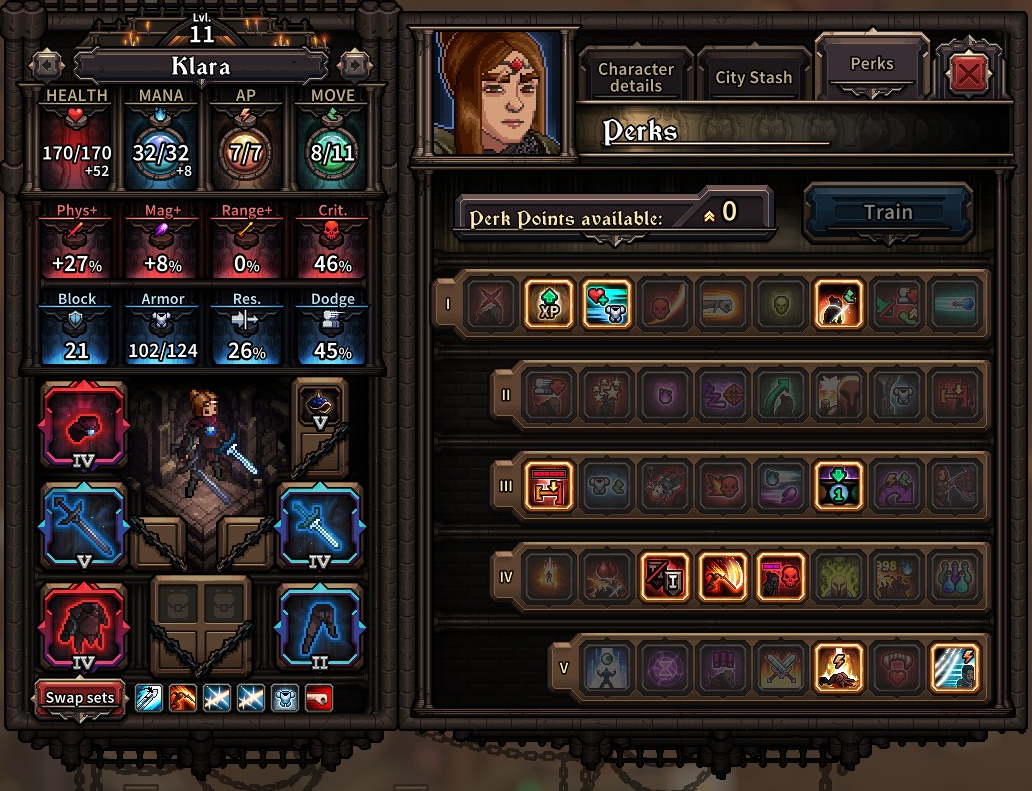
Pros: A very satisfying and fluid playstyle that it takes time to master. You start to see packs of monsters differently when you’re trying to weave holes through them. Some higher end styles of swords (silver and adamantine) have very good native stat modifiers. Generate GIGANTIC BIG NUMBERS when you crit the last boss for literally 7000 damage with a huge Momentum strike, which you can then take a screenshot of and post on Discord, much to my annoyance. Obligatory personal high number record below:
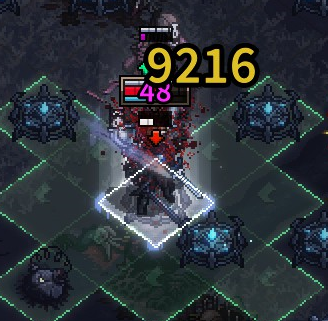
Cons: Huge momentum strikes are not useful outside of Night 12. If you haven’t noticed, we’re being attacked by hordes of zombies here, not several really big zombies. You need to put up quantity if you want a seat at the table, and the Fencer doesn’t put up quantity; they put up quality. They do what they do well, which is single target damage, and some nifty dashes through spotty packs. Ultimately you really just don’t kill that much stuff compared to other top tier melee and most archers or mages. This is because you’re the most position-intensive weapon in the game. Big square packs without holes will send you running back to your burning walls. Damage itself, outside of Momentum, is only really average. Ideally you want to build pure dodge to take advantage of the good gear available to high movement melee users and not get bogged down by having heavy armor, but sometimes forcing dodge doesn’t work. And if you have a dodge malus hero, forget it; armor based Fencers will want to get hit because they will take Berserk, but you’re stacking so much movement and moving around a lot, so sometimes you’ll find yourself on the edge of a pack and not in the middle of it, where a true armor-user wants to be.
Playstyle: Single-Target, Support Damage
Hopefully, the pack has some holes in it. A perfect Fencer will approach a pack with his sword and zip through 3-line monster chains, killing them all. Ideally, you have an offhand sword as well and Specialist, meaning you can use this ability (with 8AP) six times. That’s 18 perfect, clean, beautiful kills. If this situation doesn’t happen, target the big boys with Momentum strikes.
Stat Priority: Movement Points, Physical Damage, Crit, Dodge, Crit Damage.
Perk Order: Avid Learner, Swift as the Wind, Coagulation, Thrifty, Confident, Specialist, Relentless, First Blood, Adrenaline Rush, Energized.
Best Friend: Someone to poke holes into the monster pack so that the Fencer can dash through them, so anyone with good single target and range. Longbow or Wand user probably synergize best.
Verdict:
Damage: C
Defense: B
Mobility/Range: A
Rating: C-Tier
Greatsword – The Hero
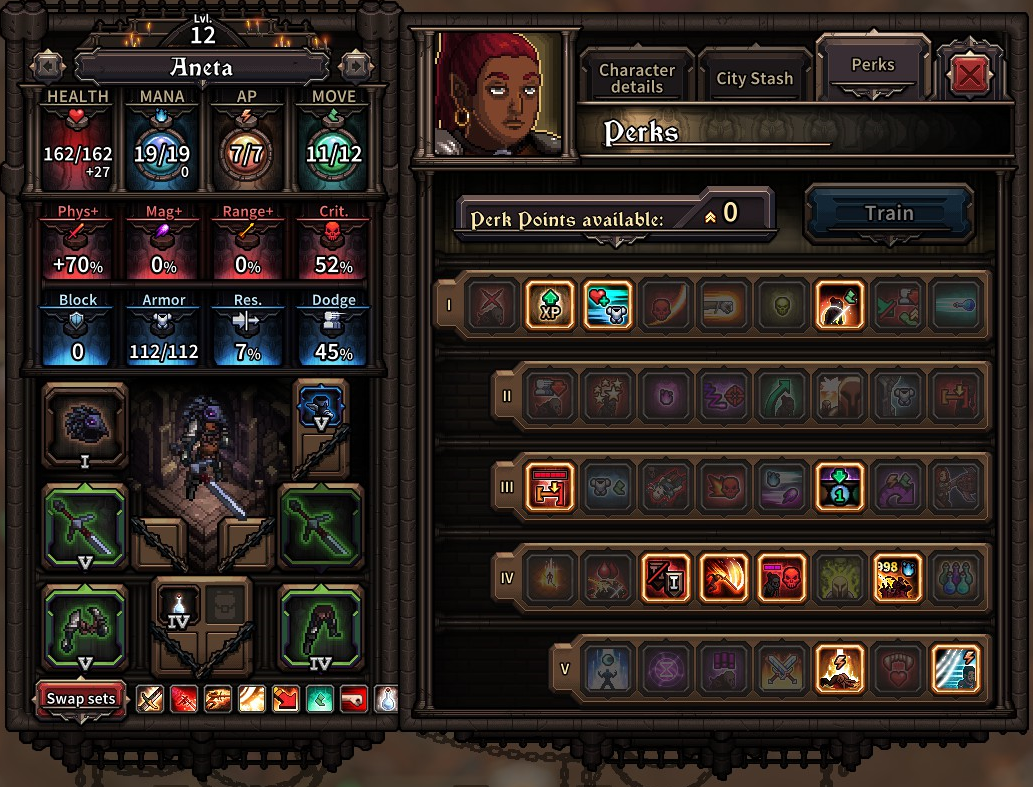
Pros: Monsters fear you, all other melee want to be you. The Hero is the apex of melee viability, second only to the Berserker in terms of raw damage and positioning. But the Hero is more dependable, which is what you want to get out of your builds in this game. The Hero has very good, compact AOE, an amazing movement skill in Charge that gets you where you need to be fast and kills everyone in front of your landing point. In addition to this, he also has access to a potent Momentum skill for taking out big targets. All around, very solid.
Cons: At the end of the day, you’re still hitting things with a sword. In this game, that means you’re punching above your weight. Without enough movement points, the Hero can struggle, and considering they’re usually built glass-cannon Dodge style, they can sometimes die if caught by a stun. Building them as armour isn’t usually as good, because they don’t benefit as much from taking the Berserk perk later on; their damage is already very high, so they benefit more from the AP of Adrenaline Rush. Their most rewarding abilities are also mana intensive, meaning you need to keep an eye on that.
Playstyle: Carry
Yes, the Greatsword can carry. They can solo 2 star walls past day 8 on Apocalypse difficulties. They are not as reliable of a carry as an Archmage or a Sniper, but you’re never unhappy to have one if you’re using melee. What you want to be doing is connecting to the pack with Charge, and then Sword Blasting everything into the ground. If there’s a big lad left standing (or a nearby Dryad) Thrust them in half with a 10-12 tile boosted Momentum hit.
Stat Priority: Movement Points, Dodge, Physical Damage, Crit, Crit Damage.
Perk Order: Avid Learner, Swift as the Wind, Coagulation, Thrifty, Confident, Specialist, Relentless, First Blood, Adrenaline Rush, Mana Collector, Energized.
Verdict:
Damage: A
Defense: B
Mobility/Range: A
Rating: A-Tier
Axe – The Barbarian
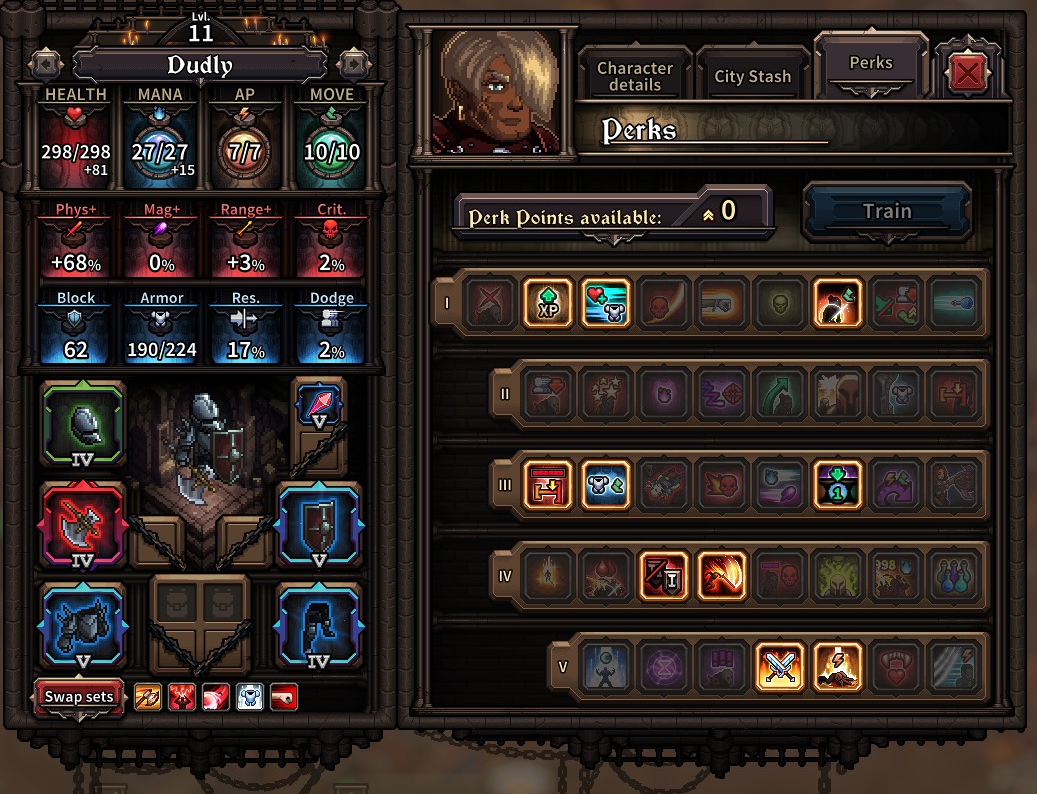
Pros: Low AP skills mean you never stop chopping, your shout can save people from dying sometimes, and it’s actually really good for spreading around targets for someone with an Opportunist skill. If you think hard enough you can remember the day when you used to be good.
Cons: ACCURACY MALUS ON AXES. This is the weapon killer. Many axes roll a native accuracy malus, and in addition to the accuracy penalty on Shred, you’re missing a lot. On night 1. On mobs that don’t have high dodge. On later difficulties and later nights, you aren’t hitting anything, and Dodgers will laugh in your face and kill your friends. When you do hit something, you leave weird holes in the pack because your low accuracy always leaves stragglers. Intimidating Scream used to shred Resistance in the beta, but now it doesn’t, and it’s depressing. You have to get close to kill things with an Axe, and you don’t have movement skills at all, meaning you’re at the mercy of gear and level up rolls to do anything. You need Skill Range for Axe Boomerang to really shine, which is a tough stat to come by. A lot of problems here, and investing in the accuracy stat is not negotiable, which is something most melee only need a little bit of effort to work out. And I don’t know about you, but missing all the time upsets me.
Playstyle: Ideally you’ll just use your huge Skill Range that you acquired with getting perfect gear to throw nice clear Axe Boomerangs at everything and do okay. But most of the time you’ll just durdle into the wave and try to attack three adjacent targets with Shred, miss 1, and then have someone else do the work while you start screaming at the pack so it doesn’t kill you.
Stat Priority: Accuracy, Move Points, Skill Range, Physical Damage, Non-Dodge Defenses
Perk Order: Avid Learner, Swift as the Wind, Coagulation, Thrifty, Armor Master (if you have heavy armor), Specialist, Relentless, Berserk, Confident, Energized.
Best Friend: Someone who can do damage, or an Opportunist user.
Verdict:
Damage: F
Defence: D
Mobility/Range: D
Rating: F-Tier. See me after class.
Greataxe – The Berserker
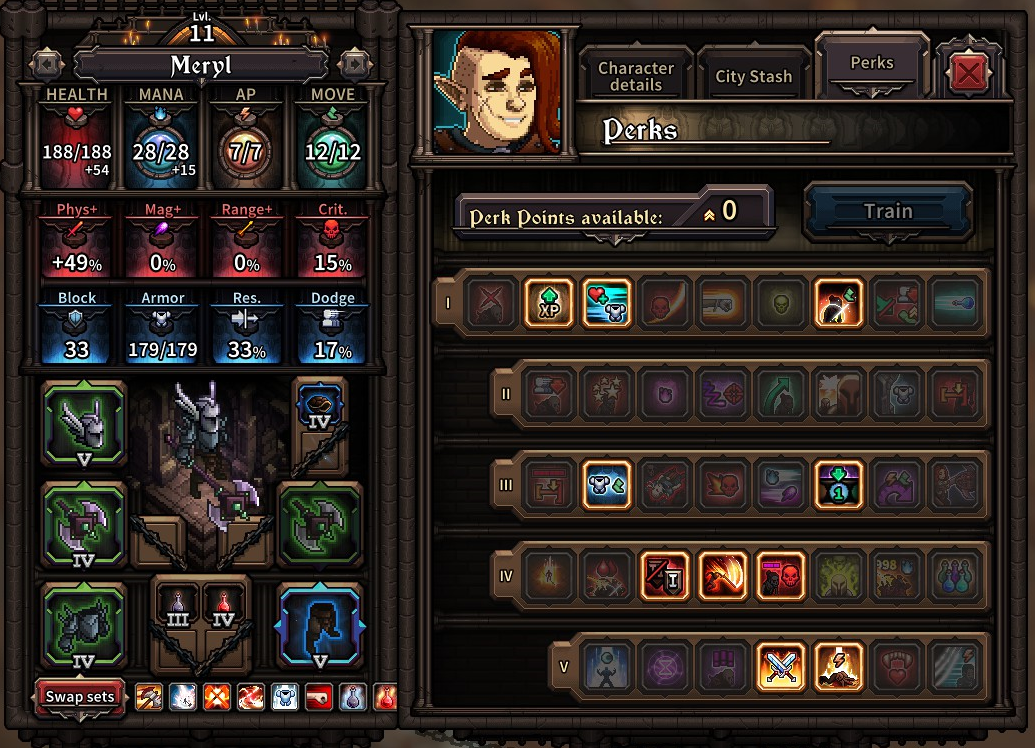
Pros: Welcome to the best damage melee has to offer. You are a highly mobile, insanely strong, very good target selecting carry that can wipe out upwards of 24 targets a turn with the correct positioning. Much like the greatsword-wielding Hero, the Berserker has a great AOE attack and a lot of mobility to back it up. He can also debuff enemies to set up Opportunist strikes for other characters. Great Axes have very high base damage, so you don’t always need to go crit, either, although it’s always good.
Cons: If you’re like me, you want to get value. I’m always looking for value. I want my Super Spin to hit 12 targets, or at least 10, every time I use it. This means you’re going to be leaping into packs and standing in the most dangerous place in the game: fully surrounded on each side by multiple thick lines of enemies. Until you hit mid-to-late game perks, this can get you dead. Just be smart and know your limitations.
Playstyle – Carry
Jump in. Swing axe. Collect heads. Do it again. Jump out (until you’re at high Dodge or Armour thresholds) or stick around to keep chopping. You basically want to get as much action as possible, all the time. This is not a melee class to be played as a support or a tank or a disruptor. If you want the most bang for your wang, you need to get in there.
Stat Priority: Movement Points, Physical Damage, Crit, Dodge or Armour, Crit Damage.
Perk Order: Avid Learner, Swift as the Wind, Coagulation, Thrifty, Armor Master (if heavy armor) / Confident (if light, dodge-based armour), Specialist, Relentless (important!!), First Blood, Berserk (if armour) / Adrenaline Rush (if dodge), Energized.
Verdict:
Damage: A
Defence: C
Mobility: A
Rating: A-Tier
Ranged Weapon Introduction
Generally, ranged units want to prioritize Skill Range and pure damage level ups because they can. There really aren’t a lot of “wrong” ways to build a ranged unit, unlike melee. You can even grab heroes that have different starting classes and force them into using a bow because bows are so powerful.
It should be said there are numerous econ strategies that involve building only ranged units and bowyers and completely trivializing the game. This guide will not cover that, as you can find that information easily on basically any YouTube video on The Last Spell. Check it out if you want to do a few mindless essence runs atop a watchtower, but for my time, it’s more valuable to find the inns and outs of mechanics and experiment with everything while also beating the game cleanly on the highest difficulty. Ranged units are currently overtuned. The will likely not always be. So if you learn the game by only playing them, you’re going to start to stutter when you start playing on high Apocalypse and can’t find the only weapon you know how to use.
Every team wants ranged units. Let’s look at some.
Shortbow – The Sniper
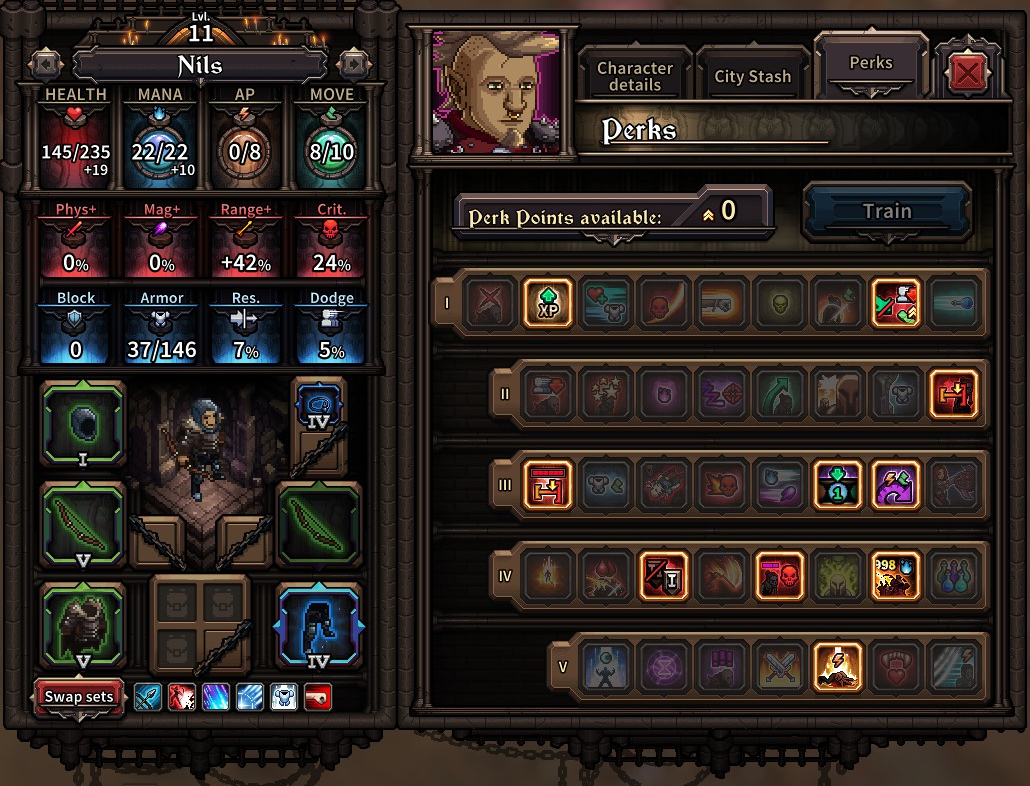
Pros: Well, here we are. The Sniper kills everything in the game effortlessly. This includes killing dodgers without worrying about them doing what they do, killing runners who broke through your line with a short-range Power Shot, killing tightly placed rectangle packs with Tight Volley, and wiping out 7-target spreads with Arrow Rain. The Shortbow is the best weapon in the game with minimal investment, and it isn’t particularly close. There isn’t really much to write here. It’s just the shortest possible bow.
Cons: Sometimes packs will be too spotty to use Arrow Rain properly. Sometimes, in rare instances, you can *only* kill stragglers, but you can kill them very easily. That’s it.
Playstyle: Hard Carry.
Drop Arrow Rain on everything first, then chop up smaller packs with Tight Volley. Any AP leftover can kill stragglers with Precise Shot. If you do even half of this a turn, you’re ahead.
Stat Priority: Ranged Damage, Crit, Skill Range, Crit Damage, Accuracy.
Perk Order: Avid Learner, Steady Aim, Cherry Picking, Thrifty, Confident, Specialist, First Blood, Mana Collector, Energized, Patient.
Best Friend: Shortbow users like to have a support class with them, because they do so much work themselves. A rifle using Sharpshooter is probably best, because they can slow the wave with Suppression and Assassinate big targets the shortbow might not kill. But the shortbow will probably just kill them too.
Verdict:
Damage: S
Defence: B
Mobility/Range: S
Rating: S-Tier. Don’t even joke.
Rifle – The Sharpshooter
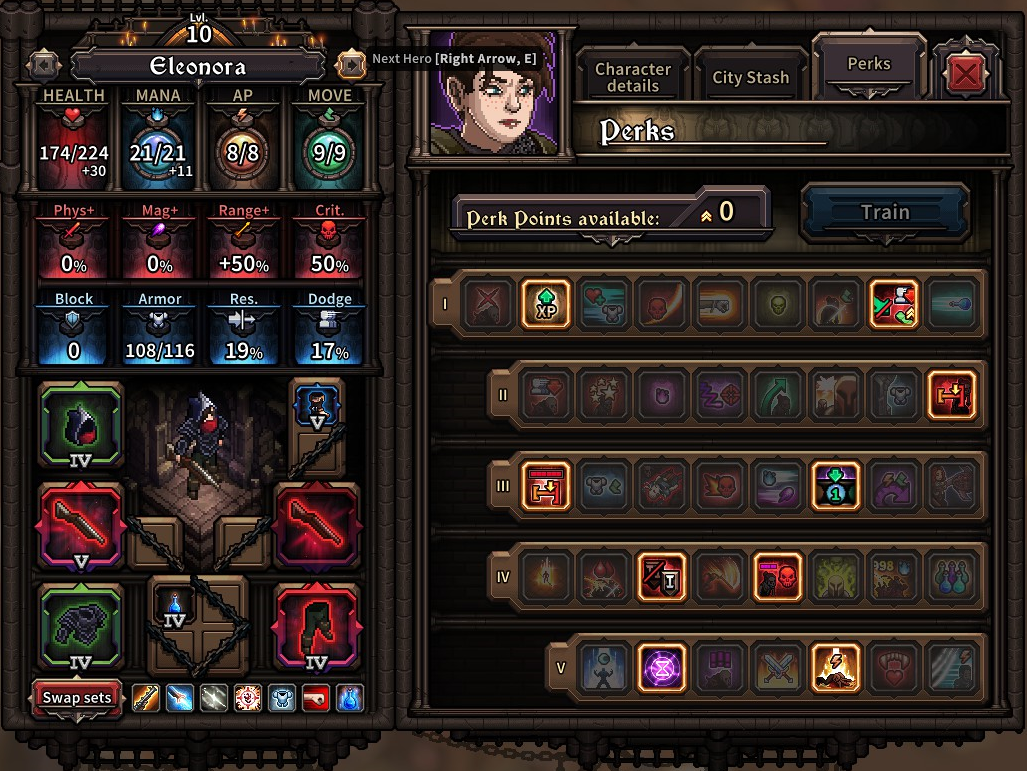
Pros: Delete boomers. Delete dryads. Delete lancers. The Sharpshooter has Assassinate, which is the highest single target ability in the game. This means that if you have one problem or a couple of big problems, the Sharpshooter can solve ’em. Most of the time however, the Sharpshooter is doing something more useful, which is casting three rounds of Specialist and Hex boosted Suppressing Fire on a long rectangular wave of enemies, reducing their movement points by 3 and damage by 20% for two turns. That’s a huge debuff, and potentially the best one in the game.
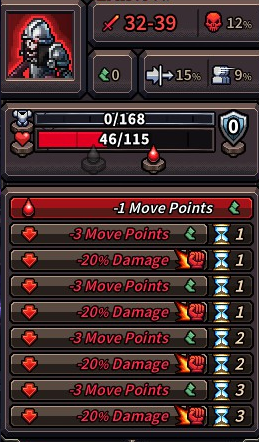
Cons: Maybe kills 5 targets a turn. This game is a DPS race, so if your Sharpshooter is trying to pretend he’s going to carry you, you’re screwed. The Sharpshooter, despite his big rifle, is a support class and needs to be treated as such, and put on teams as such. High AP abilities are also a problem here, meaning Sharpshooters don’t really excel until you have some AP meta or investment, which is harder to come by. Hip Shot is pretty bad in any circumstance.
Playstyle: Single Target Damage/Debuffer
Decide what your wall needs – either a long line of enemies nearly permaently debuffed so someone else can easily kill them, or less tall targets walking around with their heads still on their bodies. Assassinate the big ones and suppress the rest.
Stat Priority: Crit, Ranged Damage, Crit Damage, Skill Range, Accuracy.
Perk Order: Avid Learner, Cherry Picking, Steady Aim, Thrifty, Confident, Specialist, First Blood, Hex, Energized, Patient
Best Friend: Someone who can mob up debuffed enemies, a Druid specifically as they can not only Bee Sting a Supressed wave, but also use their single target for debuffed stragglers.
Verdict:
Damage: B
Defence: C
Mobility/Range: A
Rating: B-Tier
One Handed Crossbow – The Arsonist
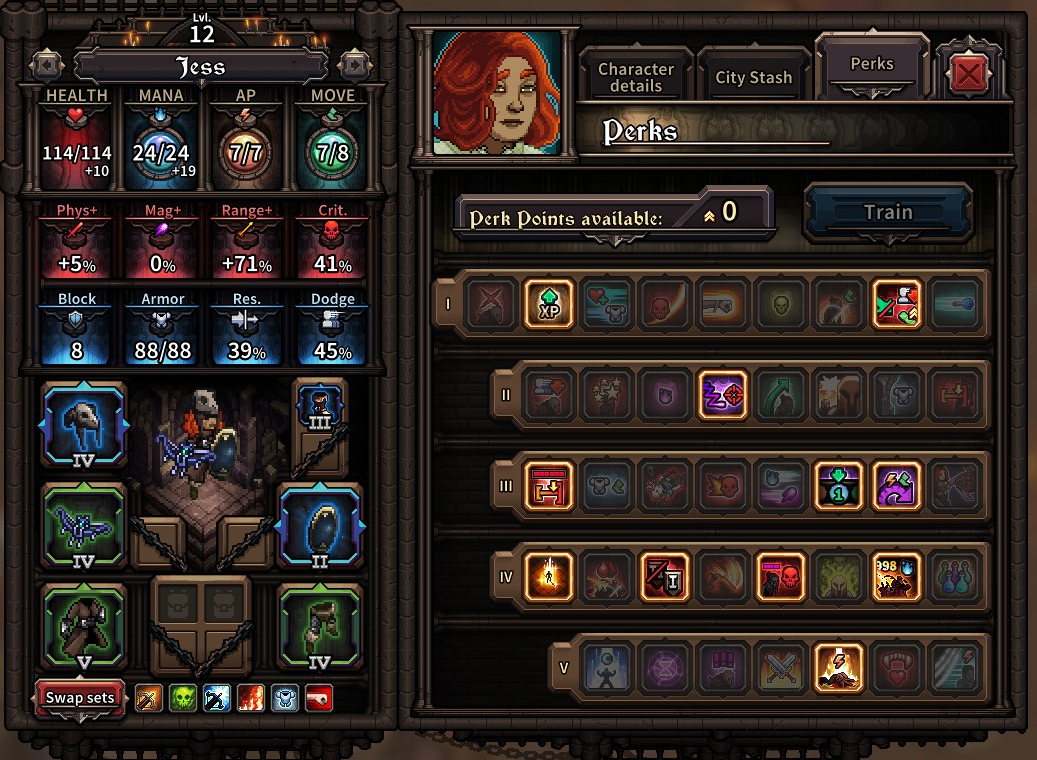
Pros: It’s funny, because you wouldn’t think that a simple small hand crossbow was able to burn down the entire screen, but it can. Blaze is probably the best ability in the game, if not the second best. It’s a Multi-Hit ability that also has Propagation, meaning your potential amount of dead-as-hell-burnt-to-a-crisp zombies is insanely high. The numbers work like this, assuming a big square pack. At minimum, with Initiator, you’ll have 3 shots of Blaze. These shots will then bounce, minimum, 5 times. That’s 15 targets, easily, with just one perk investment. The bustedness of this comes when you get any amount of Multi-Hit or Prop bounce on gear or levels, and there’s a lot of gear. You have can five shots of blaze that bounce or 8 times, killing 30+ targets a turn. No one else in the game puts up those numbers, not even the Shortbow gods.
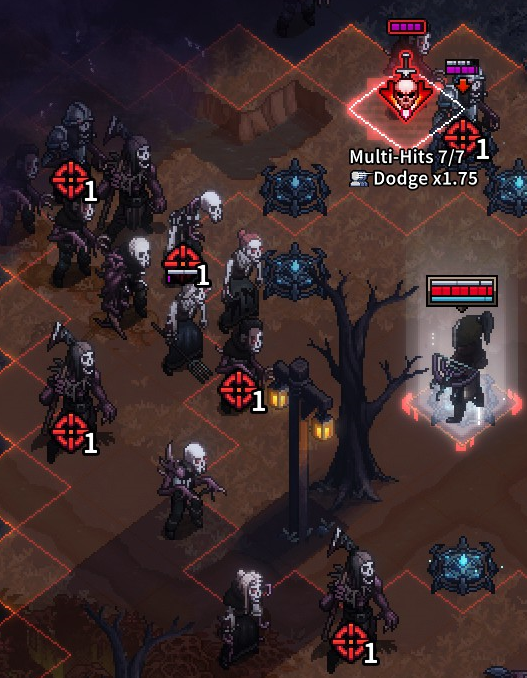
Cons: Yeah sometimes you just don’t get a good Propagation pack, and you’ll run out of targets for Blaze bounces. However, this is what I call a good problem to have. If your problem is that there aren’t enough good targets to kill, then just kill the other ones, which you can do very easily, because even if Blaze isn’t bouncing around it still does extremely high damage. The only real cons to the Hand Crossbow is that the other abilities besides Blaze are lackluster. Don’t ever poison anything with this. Don’t invest in poison. Burn, burn burn.
Playstyle: Carry.
Find targets to set on fire with Blaze, then set them on fire. Propagation works best if you target the mobs on the end of the chain first, then work your way in. After that’s done, enjoy your barbecue.
Stat Priority: Multi-Hit, Propagation Bounces, Ranged Damage, Crit, Crit Damage
Leveling Order: Avid Learner, Initiator, Steady Aim, Thrifty, Confident, Specialist, First Blood, Energized, Mana Collector, Patient, Lone Wolf (if you really are soloing your wall)
Best Friend: Forget it. You can do this by yourself.
Verdict:
Damage: S
Defence: C
Mobility/Range: A
Rating: S-Tier
Longbow – The Marksman
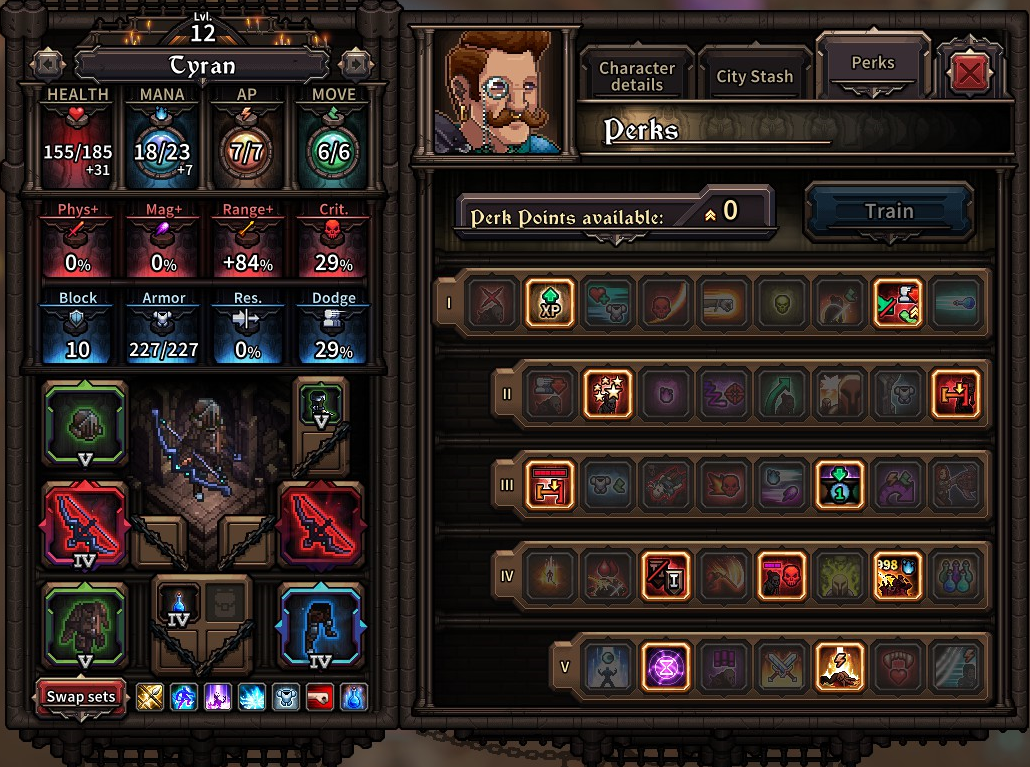
Pros: Cool as ice. Can freeze and stun potentially 27 mobs a turn and (unlike the Battlemage) also kill most of them if Specialist is taken. Very good single target, almost as good as a Sharpshooter, and access to the best defensive ability in the game in Overwatch, which gives the target +40% dodge. This is a very handy ability to have, which can save lives or make your Dodge tanks literally invincible, and guarantee they get a full turn of double AP every turn. It should also be said that the Marksman deletes single targets almost as well as classes that only delete single targets, making him a treasure on every single team. Will do work no matter his rolls or investments. Getting extra stun points feels even better. The Longest Possible Bow.
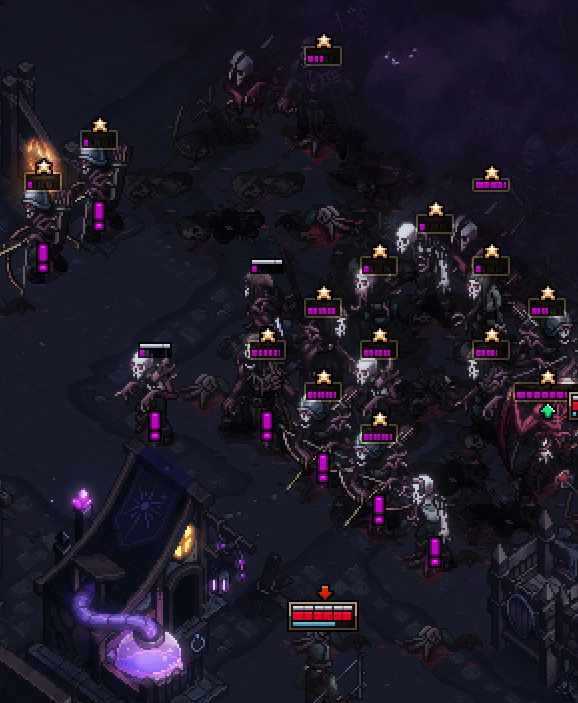
Cons: No short range stuff, so has to run around a bit if you get swarmed. Longbows themselves have a reliability malus, so until you get your reliability perks, you can find yourself not quite finishing the job sometimes. But that’s about it. This is a great weapon and a great build.
Playstyle: Carry / Support Damage
Each turn, you need to decide if you want to stun and kill as many targets as possible, or buff someone with Dodge and take out stragglers. At later levels and with more AP, you can do both. That’s one of the reasons why this weapon is so strong, it always presents you with many options for the situation at hand. A Marksman might not be able to carry an entire team by himself, but he can certainly handle his side of the wall. If Shortbows and Hand Crossbows weren’t kinda overtuned, this would be the perfect example of a ranged weapon. It’s pretty close to optimally balanced.
Stat Priority: Skill Range, Ranged Damage, Stun Chance (to a certain threshold, say 100%), Crit, Crit Damage.
Perk Order: Avid Learner, Steady Aim, Stunning!, Cherry Picking, Thrifty, Confident, Specialist, First Blood, Hex, Mana Collector, Energized.
Best Friend: Everyone is your best friend as the Marksman, but especially Dodge tanks. A Marksman and any melee with high dodge investment and Adrenaline Rush can handle pretty much any wave in the game.
Verdict:
Damage: A
Defense: A
Mobility/Range: S
Rating: A-Tier (Maybe S, but the Shortbow people would be upset)
Pistol – The Outlaw
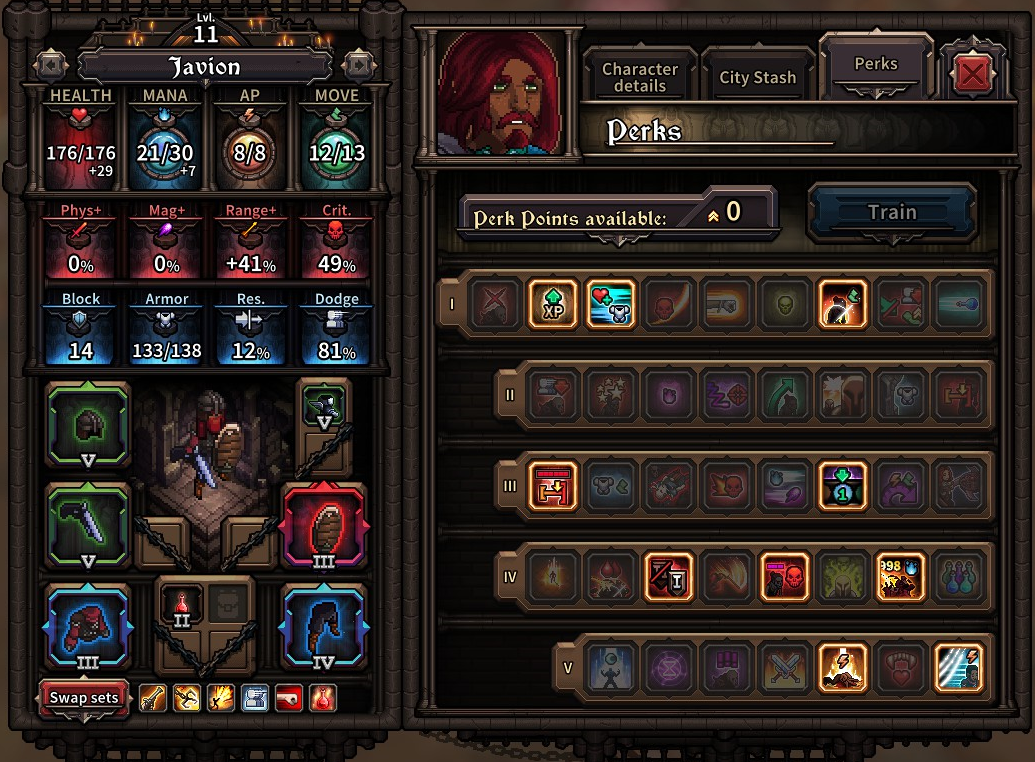
Pros: If this was a personal guide based entirely on my own experiences I would rate the Outlaw much higher than I’m going to, because Outlaws make a lot of other units look like ♥♥♥♥ in most of my playthroughs. They have so much mobility and so much concentrated and reliable power in Grapeshot, and their Momentum charged Pistol Shots rival any sword user and can be used to delete thick monsters from range. But don’t take my word for it: let’s talk numbers. Grapeshot is a very good skill. It has a respectable 9-target conal AOE that can be triggered from afar: think of the conal AOE that spears have, but able to be shot from 6 tiles away. Grapeshot also ignores dodge, which allows you to erase dodgers and other problem units on late nights on high difficulty. You also get the added bonus, if you can find one, of going Bloodborne style and having another Pistol in your offhand, giving you a spectacular 4 Grapeshots per turn with Specialist, for an (ideal only) total of 36 lead-filled corpses. Those are Tome of Secrets or Shortbow numbers. With a Pistol (with, admittedly, an offhand that those two weapons don’t need). Still, pew pew.
Cons: Unfortunately Grappling Shot is pretty bad. It often doesn’t kill its target outright, leaving you just sitting around and not being pulled to your target to blast ’em with Grapeshot. Low base damage on Pistols also means you need fairly good gear, and without high damage modifiers, sometimes Grapeshot won’t get the job done. The conal AOE on Grapeshot is also a little tough to position, but that’s why we stack movement.
Playstyle: Support Damage/Single Target
Listen. The Pistol is very misunderstood and gets played, built, and prioritized improperly. The Pistol, while a ranged weapon that scales from ranged damage, should be played on a melee hero and built like one. You want to be in the fray, dodging left and right, and stacking AP with Adrenaline Rush so you can massacre zombies with consecutive Grapeshot. If you build your Outlaws like an average Short or Longbow user, and treat them like a vanilla ranged unit, you won’t do numbers and you will fall behind. This is how most players view Pistols. But if you build him like an extremely mobile melee unit with above-par AOE damage, you’ll see what I’m talking about. Grapeshot’s dodge cancelling powers even negate the latent inaccuracy malus all other ranged weapons have. Starting to sound like a melee unit yet?
Stat Priority: Movement Points, Crit, Ranged Damage, Dodge, Crit Power.
Perk Order: Avid Learner, Swift as the Wind, Coagulation, Thrifty, Confident, Specialist, First Blood, Adrenaline Rush, Mana Collector, Energized
Verdict:
Damage: B (A-Tier with dual pistols)
Defence: A
Mobility: B
Rating: B-Tier (A-Tier with dual pistols)

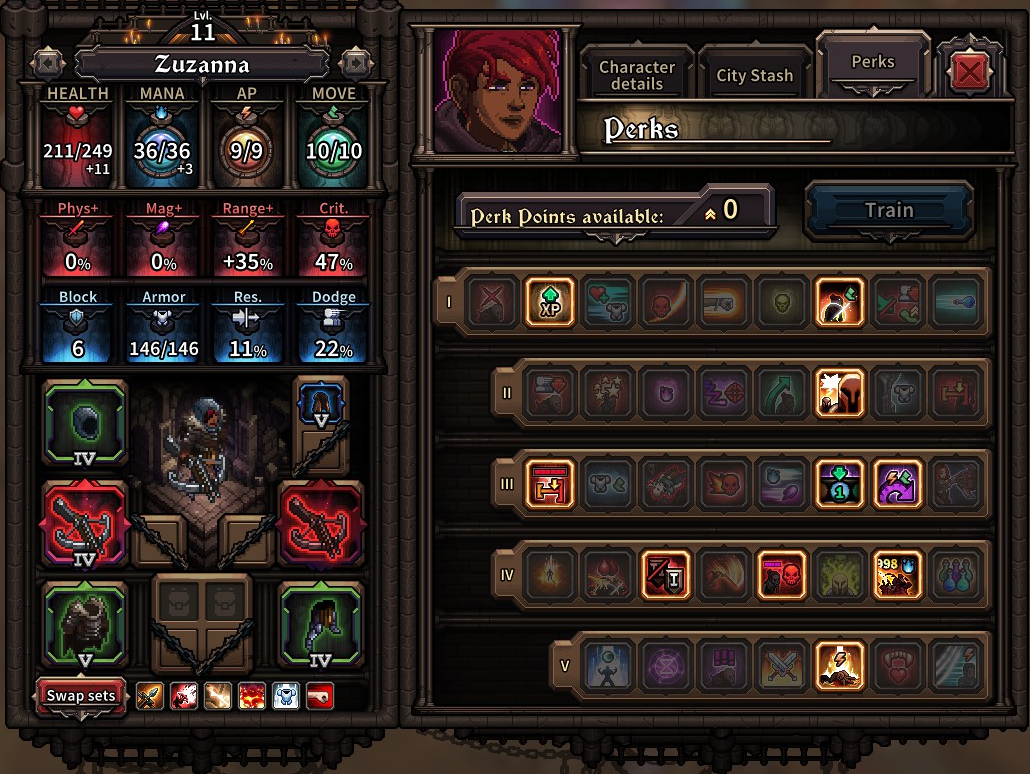
Pros: Relatively mana light, meaning you can get a bit of action early when mana regen really matters. If you get a lot of move points, you can actually get good Impaling Bolts with the right positioning. Your base damage is high, so the few things you hit usually do die. I guess you also get some cool sound effects. I’m really trying here.
Cons: None of the Two-Handed Crossbow’s abilities are tied to any mechanics. No opportunist, No isolated, No momentum. This makes it feel vanilla, and narrows level-up and itemization choices to vanilla options. In addition to this, this archer has to invest in movement points because her abilities are very positionally intensive, a stat most other archers can minimally invest in, or skip entirely. On top of that, her abilities have additional accuracy maluses to them, something other archers (with similar range) can ignore because of Cherry Picking. Heavy Bolt gets around block (of all things) but monsters that have block are usually armored anyway, and it doesn’t pierce armor. An incredibly underpowered, confused weapon that is a liability on everyone who uses it. Take one for a challenge run, or if you’re a masochist. Then again, if you’re a masochist, just make a Scepter Battlemage, because the weapon is almost as bad but it at least has a playstyle and interesting itemization. The Hunter wants to play like a melee-ranged ranged unit, but almost all of her abilities aren’t usable until you get out of melee range. So you can’t even benefit from Berserk or Adrenaline Rush! Why!?
Playstyle: Cheer Bot, Occasional Damage Dealer
Once and a while, you will get a good Impaling Bolt and it’ll feel good. Most of the time, however, you’ll be sitting around wondering why you can’t get good shots, because you can’t position properly. Late game, when you can position properly, you will always do less damage than any other ranged option. In most cases, you’ll be using Cheer on the nearest hero who has literally any other weapon. I’m being a little hard here; you can kill things okay, but in comparison, not very well.
Stat Priority: Movement Points, Ranged Damage, Crit, Crit Power, Accuracy.
Perk Leveling Order: Avid Learner, Swift Like the Wind, Cheer, Thrifty, Confident, Specialist, First Blood, Mana Collector, Energized, Patient
Verdict:
Damage: F (D with good investment and positioning, but why bother with so many better options)
Defense: D
Mobility/Range: D
Rating: F-Tier.
If you beat Apocalypse 5 with more than one Two Handed Crossbow, DM me and I’ll buy you a beer
Magic Weapon Introduction
Unfortunately, The Last Spell doesn’t have a lot of mage-specific perks outside of Magic Fuel, which not all heroes get enough mana to really utilize properly (although, it’s always a nice goal to have). This means, and this is not necessarily a bad thing, that all mages must build crit (although some more than others), in order to get effective engagement with the perk tree. The only problem with this might be if you get a mage that has a crit malus. You’re gonna have a bad time. Magic users have some very cool and unique interactions (especially the Orb users) and their playstyles are always rewarding. There’s a reason why everyone wants to play mages in League and stuff. People like fireworks, and the Last Spell mages are great and setting them off. Just get ready to hand in your wand to the proper authorities once we finish saving the world.
I’d make a Harry Potter joke here but I think the guide already has one.
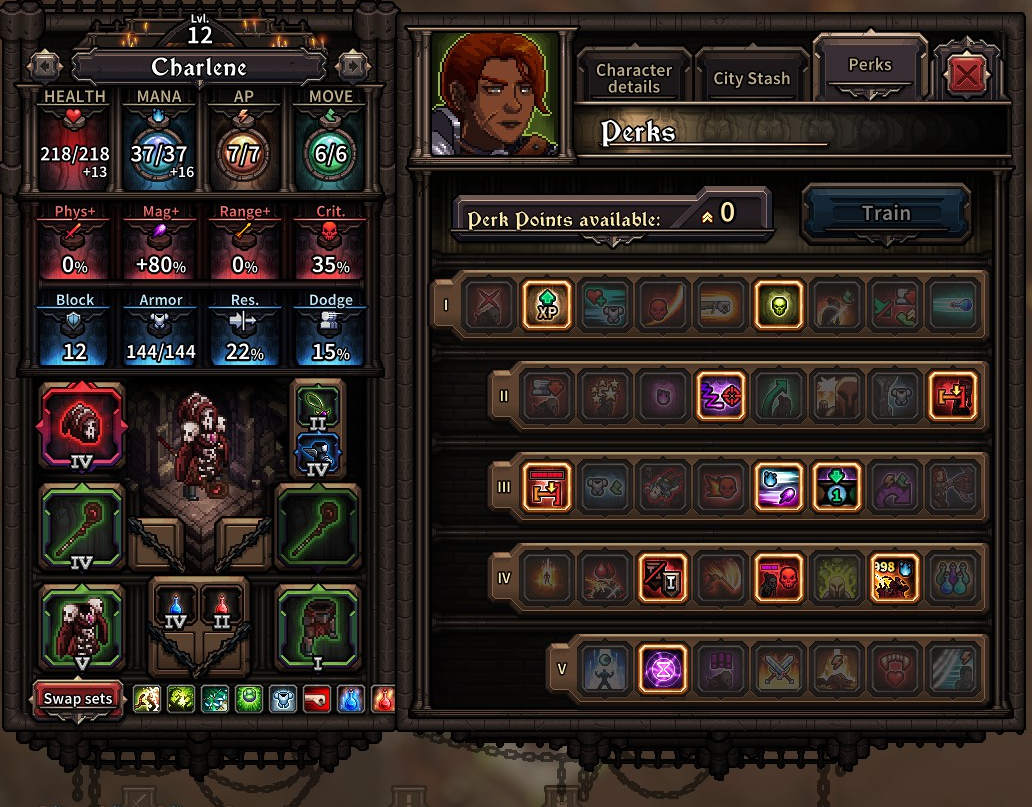
Pros: An immensely functional, high impact, diverse toolkit which reliably kills densely packed monster waves, roots the problem areas forever, executes debuffed targets, and on top of it all leaves everything poisoned. Pretty good range and low thresholds of investment required to shine. Druid staves have naturally high damage and good native modifiers. BEES.
Cons: Can be fairly mana intensive, and relying on poison to finish mobs without proper investment only costs you time. Monsters in Lakeburg that are poisoned can still kill your buildings, up your panic levels, and generally terrorize society, so by in large you want to just kill them instead. Druids often don’t get as much crit as other mages, and mages absolutely want crit to get the most value out of their perks. This is because Druids often want to take a bit of poison damage on the side, so their poison triggers don’t stay at the measly 40 damage a turn they start with.
Playstyle: Carry / Support Damage
Open up the jar of bees, put the jar of bees on the enemy, watch as the bees sting them to death. Root the ones that aren’t dead, or finish them off with Centipedes. If there’s another problem elsewhere, run over and root it until someone can deal with it later. At maximum efficiency, just clear out entire waves with bees and pretend you’re an Archmage.
Stat Priority: Propagation Jumps, Magic Damage, Crit, Poison Damage, Crit Damage.
Perk Order: Avid Learner, Initiator, Poison Damage, Thrifty, Confident, Specialist, First Blood, Hex, Mana Collector, Cherry Picking, Energized.
Best Friend: Druids spread debuffs very well. The best in the game in fact. So if you have a buddy with an Opportunist skill, they’re going to be able to go ham on your rooted packs or poisoned stragglers.
Verdict:
Damage: A
Defence: A
Mobility/Range: A
Rating: A-Tier. As solid A-Tier as it gets.
Wand – The Pupil
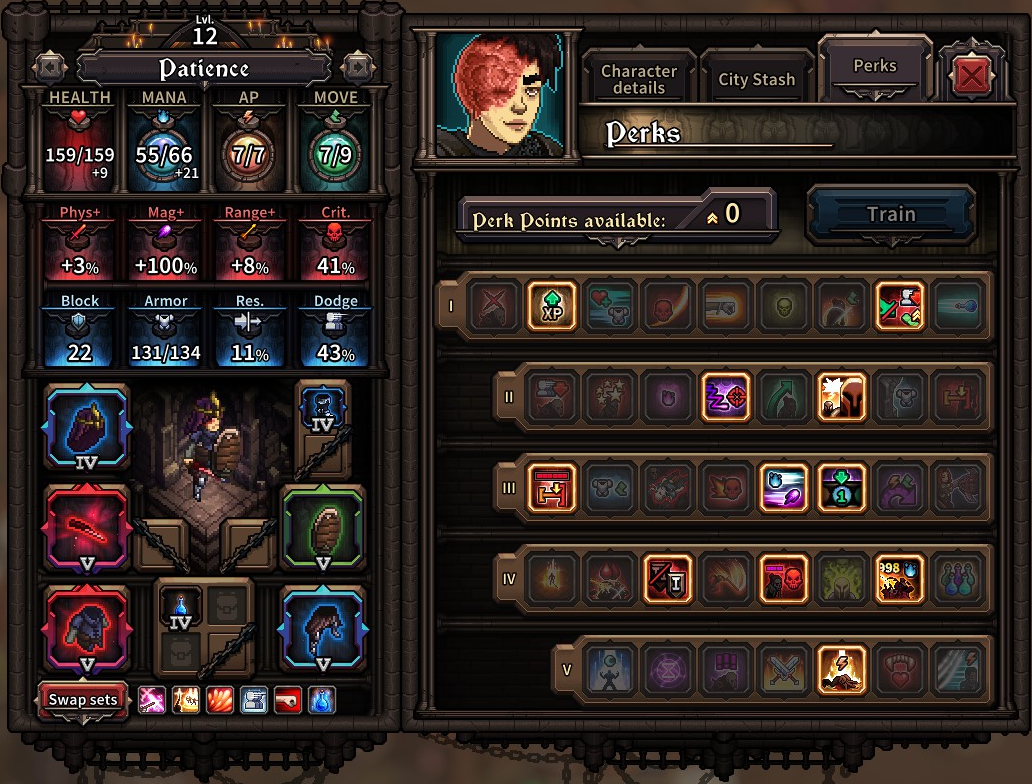
Pros: Extremely accurate, high range target selector that can pick off post enemies with a little bit of Multi-Hit investment. At high Multi-Hit breakpoints, can do high tier damage. Access to a cool and unique ability in Transfer, which anyone (especially melee) is happy to get hit with. Low AP costs mean you can keep firing wand bolts all day every day. Very efficient in what they do; most teams are happy to have a Pupil.
Cons: No AOE damage, and as a Mage, that puts you in the beat seat. The Pupil isn’t really a carry, but rather a supporting damage type that can potentially do nothing late-game without enough Multi-Hit. At least with Initiator you can kill some things, but in order to kill most things you’re going to want a few pieces of Multi-Hit gear, or some very high crit chance.
Playstyle: Support Damage, Buffer, Occasional Carry
You’ll want to open every round with Magic Missiles, and then cast it until you run out of targets. You then use Transfer to give any remaining AP you have to someone else, or Cheer to buff them. If you’re doing this every round, and you have enough Multi-Hit, you’re happy and so is everyone else.
Stat Priority: Multi-Hit, Magic Damage, Crit, Crit Damage, Mana.
Perk Order: Avid Learner, Initiator, Steady Aim, Thrifty, Cheer, Specialist, First Blood, Mana Collector, Cheer, Confident, Energized
Best Friend: Anyone. The Wand is the ultimate support class. Ideally it would be someone who needs move speed for Momentum, like a Fencer or a Hero.
Verdict:
Damage: B
Defense: C
Mobility/Range: A
Rating: B-Tier. But a friend to all.
Tome of Secrets – The Archmage
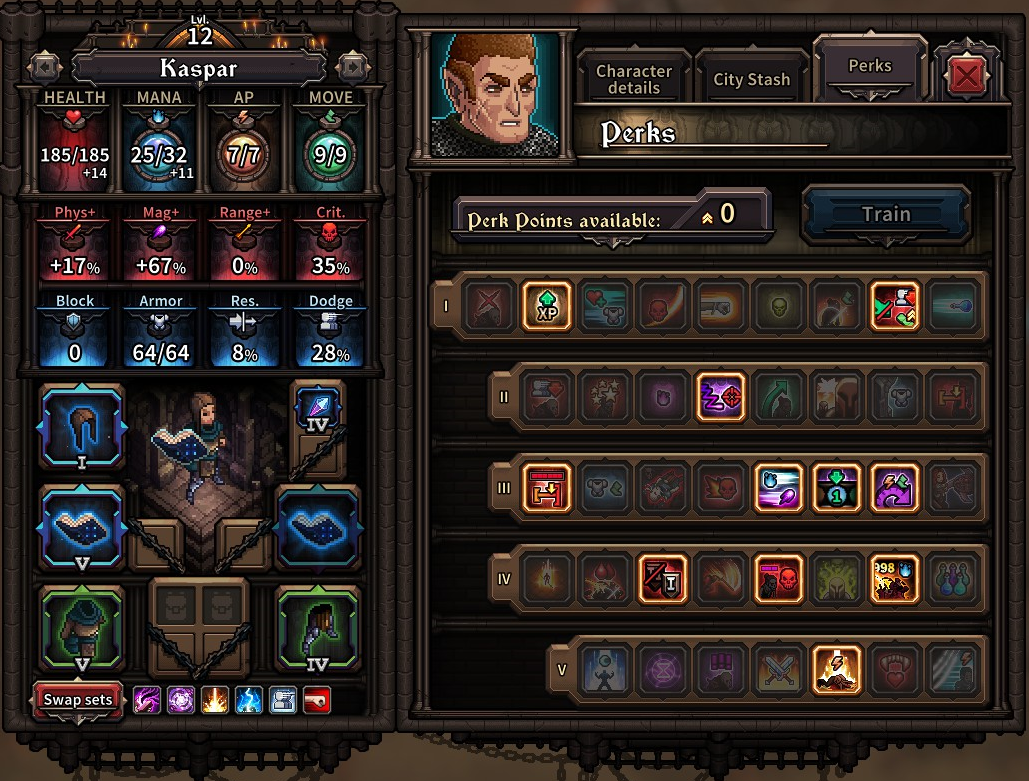
Pros: Unleash hellish propagation lightning strikes that can kill dozens with a few casts. Incinerate big targets and their immediate surroundings with fireballs. The Archmage has AOE, single target, range, and debuffs. Make other mages jealous with how big your two-handed book is
Cons: Sometimes propagation doesn’t do what you want it to, or the wave isn’t a good prop target because of bad spacing. High mana costs before thrifty and mana collector kick in. Must go crit, or will be lackluster and struggle with mana. Lacks move speed options, so can get line of sighted sometimes.
Playstyle: Carry.
On meaty packs, open with a Weakening Touch chain to shred resistance, then start throwing the Zeus juice. Clean up stragglers that didn’t get electrocuted with a Shadow Bolt. On smaller packs, fireball the thickest lads and have the splash damage roast their next of kin.
Stat Priority: Prop Chain, Crit, Magic Power, Mana, Crit Damage.
Leveling Order: Avid Learner, Initiator, Steady Aim, Thrifty, Magic Fuel, Specialist, Mana collector, First Blood, Confident, Energized.
Best Friend: Being able to shred resistance with weakening touch chains means that the archmage works well with a Druid, Lightmage, or Knight, who all want debuffed targets for their Opportunist skills. But the Archmage can work alone and handles walls by herself fairly easily.
Verdict:
Damage: A
Defense: C
Mobility/Range: B
Rating: A-Tier
Scepter – The Battlemage
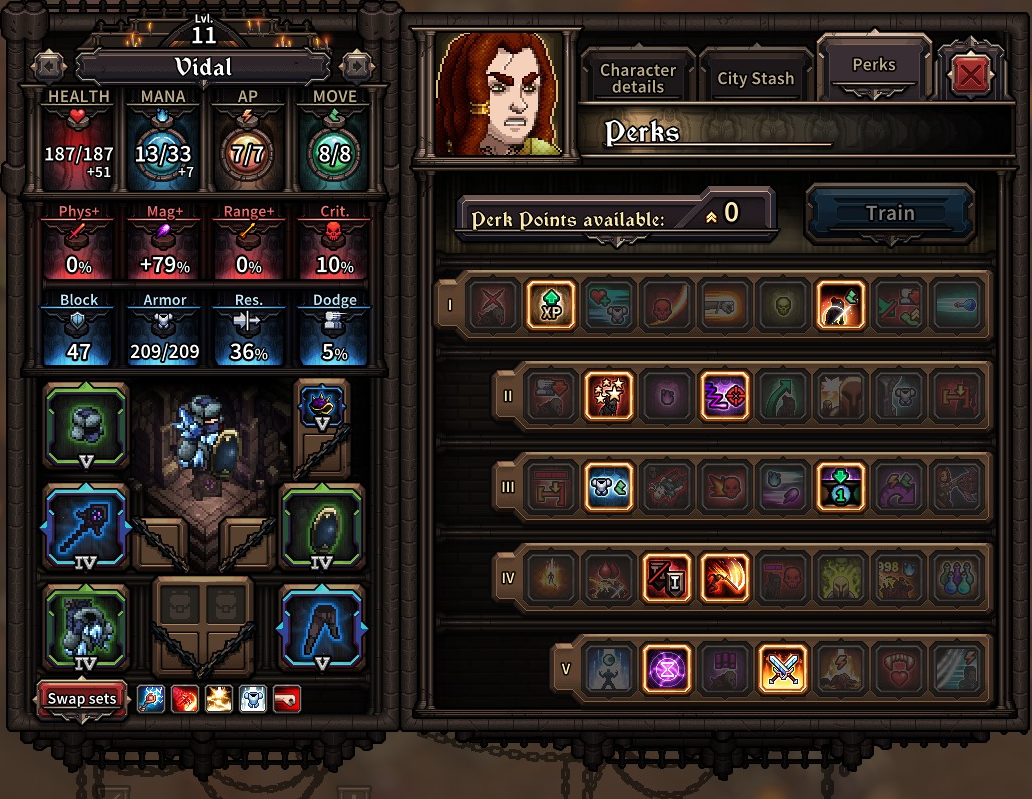
Pros: Is the Battlemage a good aoe damage dealer? No. But is the Battlemage a melee boxer who can dish out short range pain? Also no. However they are the technically best stunner in the game with high Propagation, and can’t be killed due to natural defense stat rolls on most Scepters and good mage armor items like frost or devil gear. Probably highest resistance hero possible as well, as some scepters have resistance on them naturally. Pretty fun.
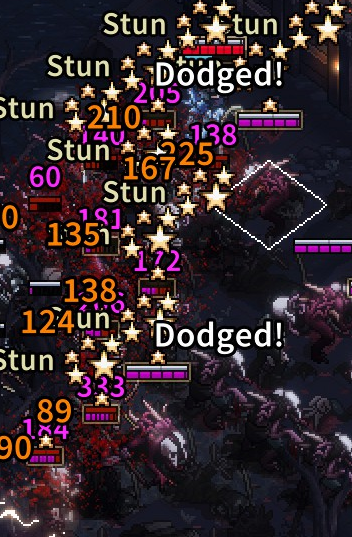
Cons: Do basically no serious damage of any kind, Struggle with mana investment as you need other stats mages do not, often fall behind on mobility with other melee as your gear doesn’t naturally roll it. Difficult to build crit or dodge because of other stats needed. Axtra difficult to find the right hero, although some are stellar (angelic blood, shaman, paladin). The wave will be stunned – but not dead. You want them dead.
Playstyle: Tank/Disruption.
Three Hammer of Faith per turn (with Specialist), then one big momentum hit, or two Hammer of Faith and a Relentless boosted Shock Touch.
Stat Priority: Move Points, Propagation Jumps, Magic Damage, Skill Range, Stun Chance,
Perk Order: Avid Learner, Initiator, Swift Like the Wind, Thrifty, Stunning!, Specialist, Relentless, Berserk, Hex, Mana Collector (if crit), Armor Master, Magic Fuel.
Best Friend: Longbows. You will absolutely, 100%, stun every single mob on your side of the wall. You set them up, the longbows knocks them down.
Verdict:
Damage: D
Defense: A
Mobility/Range: C
Rating: D-Tier
Orb – The Deathmage
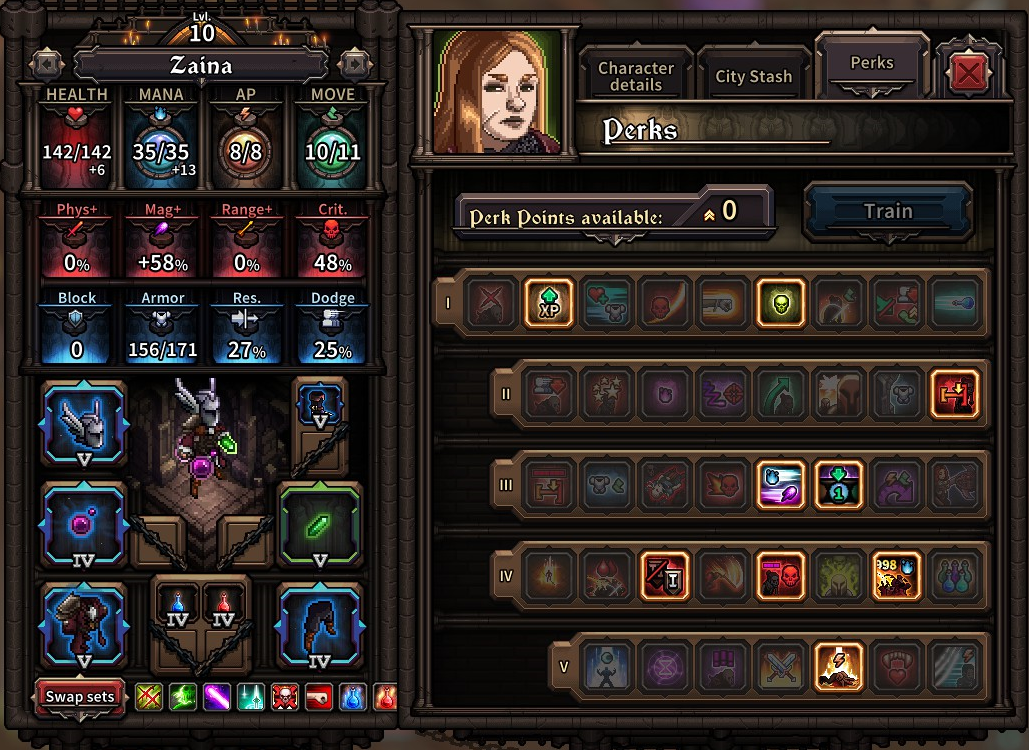
Pros: Erase all life from existence. With a good orb, a high Mana pool, Mana Potions and a Teleport Crystal, the rest of your team can stay at the inn and drink while you clear all four waves by yourself and are back in time for the last round. Doesn’t need crit investment as much as other mages to do damage, as Death Ray scales so well naturally. Can actually take the Lone Wolf perk and abuse the hell out of it. If you don’t believe me, try it. There’s no going back after you get a 50 Mana Deathmage with a Teleport Crystal.
Cons: If you make a mistake and get hit, you usually die because most orbs have a health malus. Death Ray lines can be hard to create due to monster pathing randomness. High skill cap due to smart positioning without a Teleport Crystal. Weak until you stockpile tons of mana. Can fail to reach full potential some games.
Playstyle: Carry.
Cast Death Ray three times per turn, then use Infect to clean up the stragglers (there are never stragglers). Putrid Ball can sometimes get square packs Death Ray cannot.
Stat Priority: Mana, Movement, Magic Damage, Crit, Mana Regen.
Leveling Order: Avid Learner, Cherry Picking, Potent Toxins, Thrifty, Magic Fuel, Specialist, Mana Collector, First Blood, Energized, Confident, LONE WOLF!
Best Friend: The death mage works alone. This is because she has to teleport around and start blasting, meaning she goes places no one else would dare. If anyone can hit you with cheer before you go in, that helps.
Verdict:
Damage: A (S+ with teleport crystal)
Defense: F
Mobility/Range: B (S+ with teleport crystal)
Rating: A-Tier (you guessed it, S+ with teleport crystal)
Power Staff – The Lightmage
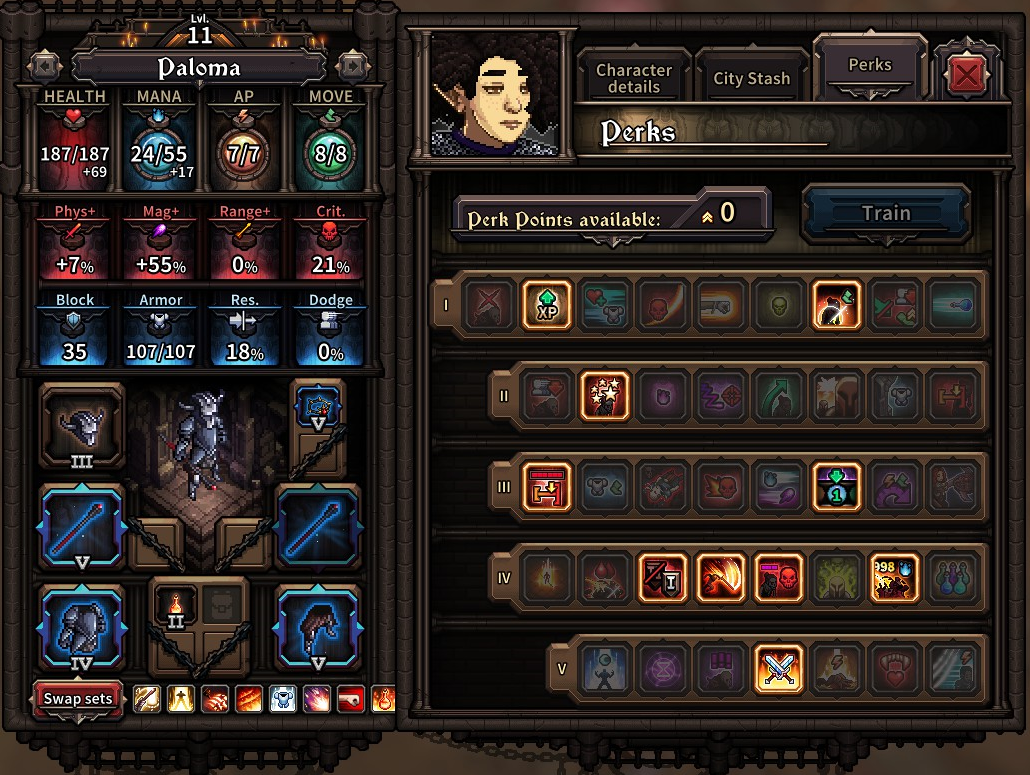
Pros: The Lightmage, much like the Battlemage, is a melee mage. But what he has, in spades, over the Battlemage is a very good teleportation-style movement skill that gets him into the fray and stuns everything around him (a very high natural chance compared to other skills, 70%) when he lands: Stunning Entrance. This skill, in addition to the debuff from Pillar of Light, let’s you set up massive damage Scorching Waves that feed off the opponents debuffed status because it has phenomenal Opportunist scaling. His best skill, however, is Fire Thrower, which is just a conal melee-range wave of fire that roasts everything with no other synergy needed, and combined with Relentless and few Berserk stacks, everything it touches dies. On paper, this is very strong weapon, and the build around it looks very strong as well.
Cons: However, the problem with the Lightmage is that he needs a lot of stats. Too many. He wants movement points so he can maneuver around packs once he teleports in, he wants mana because Scorching Waves cost a ton, he wants regular magic scaling and crit to do damage and access good mage perks, he wants stun chance to proc his Opportunist bonuses, he needs accuracy because there’s a malus on most power staves and he also needs defensive investment because he’s going to take hits. In addition to all of this, he also needs one of the rarest stats, Skill Range, to really get value out of Stunning Entrance. Many characters, most characters, won’t get all these stats from either level-ups or good gear. And if you have low meta unlocks, forget it, because you need just about everything running to make this guy work.
Playstyle: Support Damage/Tank/Disruption
Ideally, with good gear and stats, you play the Lightmage as a mobile tank, porting all over the place and unleashing hell on debuffed enemies, while not minding standing in the wave afterwards and getting slapped. The people who try to play with Power Staves as a normal magic user who doesn’t have investment in movement and defense will either be dead, or very disappointed with the lack of reliable damage the Lightmage can do. This is why the community dislikes Power Staves so much, because they try to play their users as regular casters. But they aren’t. This is a melee unit, so treat it like one. Take Swift like the Wind. Take Berserker. Take Relentless. You’re not a wizard, Harry.
Stat Priority: Skill Range, Movement Points, Magic Damage, Crit, Crit Power, Stun Chance, Amour and Health (not dodge – we need damage from Berserk, not extra AP we can use from Adrenaline Rush), Mana
Perk Order: Avid Learner, Swift as the Wind, Stunning!, Thrifty, Confident, Specialist, First Blood, Berserk, Relentless, Mana Collector
Verdict:
Damage: C
Defense: C
Mobility: B
Rating: C-Tier (B-Tier with all the stats you need. A rarity)
One Hand Crossbow, Shortbow.
A Tier:
Dagger, Greatsword, Greataxe, Longbow, Druid Staff, Tome, Orb (S-Tier with Teleport Crystal).
B Tier:
Spear, Sledgehammer (A-Tier with high Skill Range), Rifle, Pistol (A-Tier with dual-wield Pistols), Wand.
C Tier:
One Handed Hammer (B-Tier with dual-wield Hammers), Sword (B-Tier with dual-wield Swords), Power Staff.
D Tier:
Scepter.
F Tier:
Two Hand Crossbow, Axe.
Punch Tier
Punch. This was a weird run.
Related Posts:
- The Last Spell: Leveling up Guide
- The Last Spell: Damage Formulas (Damage Calculation Chains)
- The Last Spell: Infinite Gold Farming Build (Patch 1.0.2.17)

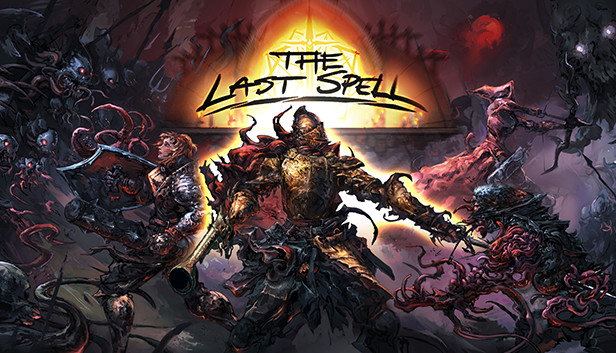
I’m with you on the hand crossbow skills other than blaze being unremarkable with the exception of quick shot. Especially with good multi-hit (which you’ll want for blaze anyways) it’s amazing for picking off stragglers. The -1 movement per hit makes it awesome for keeping bigger enemies away from your base, just in case hitting them 5 times for 1 ap doesn’t outright kill them. <3